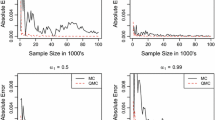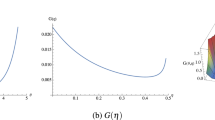Abstract
Importance sampling is a powerful variance reduction technique for rare event simulation, and can be applied to evaluate a portfolio’s Value-at-Risk (VaR). By adding a jump term in the geometric Brownian motion, the jump diffusion model can be used to describe abnormal changes in asset prices when there is a serious event in the market. In this paper, we propose an importance sampling algorithm to compute the portfolio’s VaR under a multi-variate jump diffusion model. To be more precise, an efficient computational procedure is developed for estimating the portfolio loss probability for those assets with jump risks. And the tilting measure can be separated for the diffusion and the jump part under the assumption of independence. The simulation results show that the efficiency of importance sampling improves over the naive Monte Carlo simulation from 9 to 277 times under various situations.
Similar content being viewed by others
Notes
Because the VaR calculation in this example is one period, we simply need to simulate the return processes at the last time of consideration, but not the whole paths of the return processes. As a result, Euler discretisation is not necessary. As a remark, it is known that when the jump frequency \(\lambda \) gets bigger and the discretisation period \(\Delta t\) gets longer, then the discretisation error gets bigger with the same sample size, cf. http://marcoage.usuarios.rdc.pucrio.br/sim_stoc_proc.html. The discretisation issue may arise for multi-period VaR calculation, which is beyond the scope of this example.
References
Asmussen, S., & Glynn, P. (2007). Stochastic simulation: Algorithms and analysis. New York: Springer.
Beran, R. (1987). Prepivoting to reduce level error of confidence sets. Biometrika, 74, 457–468.
Beran, R., & Millar, P. W. (1986). Confidence sets for a multivariate distribution. Annals of Statistics, 14, 431–443.
Bucklew, J. A. (2004). Introduction to rare event simulation. New York: Springer.
Davison, A. C. (1988). Discussion of papers by D. V. Hinkley and by T. J. DiCiccio & J. P. Romano. Journal of Royal Statistical Society, 50, 356–357.
Do, K. A., & Hall, P. (1991). On importance resampling for the bootstrap. Biometrika, 78, 161–167.
Duffie, D., & Singleton, J. (2003). Credit risk. Princeton, New Jersey: Princeton University Press.
Fuh, C. D., & Hu, I. (2004). Efficient importance sampling for events of moderate deviations with applications. Biometrika, 91, 471–490.
Fuh, C. D., & Hu, I. (2007). Estimation in hidden Markov models via efficient importance sampling. Bernoulli, 13, 492–513.
Fuh, C. D., Hu, I., Hsu, Y. H., & Wang, R. H. (2011). Efficient simulation of value at risk with heavy-tailed risk factors. Operations Research, 59, 1395–1406.
Glasserman, P. (2004). Monte carlo methods in financial engineering. New York: Springer.
Glasserman, P., Heidelberger, P., & Shahabuddin, P. (2000). Variance reduction techniques for estimating Value-at-Risk. Management Science, 46, 1349–1364.
Glasserman, P., Heidelberger, P., & Shahabuddin, P. (2002). Portfolio Value-at-Risk with heavy-tailed risk factors. Mathematical Finance, 12, 239–269.
Hall, P. (1987). On the bootstrap and likelihood-based confidence regions. Biometrika, 74, 481–493.
Hall, P. (1992). The bootstrap and edgeworth expansion. New York: Springer.
Heidelberger, P. (1995). Fast simulation of rare events in queueing and reliability models. ACM Transactions on Modeling and Computer Simulation, 5, 43–85.
Johns, M. V. (1988). Importance sampling for bootstrap conference intervals. Journal of the American Statistical Association, 83, 709–714.
Jorion, P. (2001). Value-at-Risk. New York: McGraw-Hill.
Kou, S. G. (2002). A jump diffusion model for option pricing. Management Science, 48, 1086–1101.
Lindsay, B. G. (1988). Composite likelihood methods. Contemporary Mathematics, 80, 221–239.
Liu, J. (2001). Monte carlo strategies in scientific computing. New York: Springer.
Merton, R. C. (1976). Option pricing when underlying stock returns are discontinuous. Journal of Financial Economics, 3, 125–144.
Naik, V., & Lee, M. (1990). General equilibrium pricing of options on the market portfolio with discontinuous return. Review of Financial Studies, 3, 493–521.
Ney, P. (1983). Dominating points and the asymptotics of large deviations for random walk on \(\cal{R}^d\). Annals of Probability, 11, 158–167.
Sadowsky, J., & Bucklew, J. A. (1990). On large deviations theory and asymptotically efficient Monte Carlo simulation. IEEE Transition of Information Theory, 36, 579–588.
Siegmund, D. (1976). Importance sampling in the Monte Carlo study of sequential tests. Annals of Statistics, 4, 673–684.
Acknowledgements
The research of the first author is supported in part by a Grant NSC 100-2118-M-008-002-MY3 and NSC 101-3113-P-008-005, the second author is supported in part by a Grant NSC 102-2118-M-008-002, and the third author is supported in part by a Grant NSC 100-2410-H-032-024.
Author information
Authors and Affiliations
Corresponding author
Appendix: Proofs
Appendix: Proofs
Proof
(Proof of Proposition 1) We first note that \(\psi (\theta )\) is the cumulant generating function of X, and therefore its second derivative \(\psi ''(\theta )>0\) for \(\theta \in \mathbf{I}\). This implies that \(\psi '(\theta )\) is strictly increasing. Since \(\Psi (\theta )\) is convex and steep by assumption, we have \(\psi '(\theta ) \rightarrow \infty \) as \(\theta \rightarrow \theta _{\max }\). Furthermore, consider the conditional measure of \(\bar{Q}\) on the set A, denoted by \(\bar{Q}_A\), which is defined as
Then we have
Since under the assumption in Proposition 1, the second and third terms in (29) are bounded for all \(\theta \in \mathbf{I}\), by Fubini’s theorem, the second equality in (29) holds. This implies that \(E_{\bar{Q}_\theta }[X|X\in A]\) is strictly decreasing. \(\square \)
Proof
(Proof of Theorem 1 ) The existence of the optimization problem (3) requires the following fact,
which has been proved in Proposition 1.
The existence of the optimization problem (3) follows from \(E_{\bar{Q}_0}[X|X\in A] = E[X|X\in A] > \mu = \psi '(0)\).
To prove the uniqueness, we note that the second derivative of G equals
Since \(\psi (\theta )\) is the cumulant generating function of X, its second derivative \(\psi ''(\theta )>0\). It then follows from (31) that \(\frac{d^2 G(\theta )}{d \theta ^2}>0\), which implies that there exists a unique minimum of \(G(\theta )\).
To prove (8), we need to simplify the RHS of (5) under \(\bar{Q}\). Standard algebra gives
As a result, (32) equals
which implies the desired result. \(\square \)
Rights and permissions
About this article
Cite this article
Fuh, CD., Teng, HW. & Wang, RH. Efficient Simulation of Value-at-Risk Under a Jump Diffusion Model: A New Method for Moderate Deviation Events. Comput Econ 51, 973–990 (2018). https://doi.org/10.1007/s10614-017-9654-z
Accepted:
Published:
Issue Date:
DOI: https://doi.org/10.1007/s10614-017-9654-z




